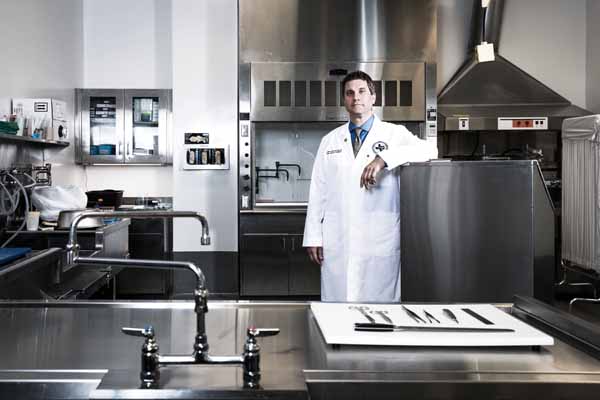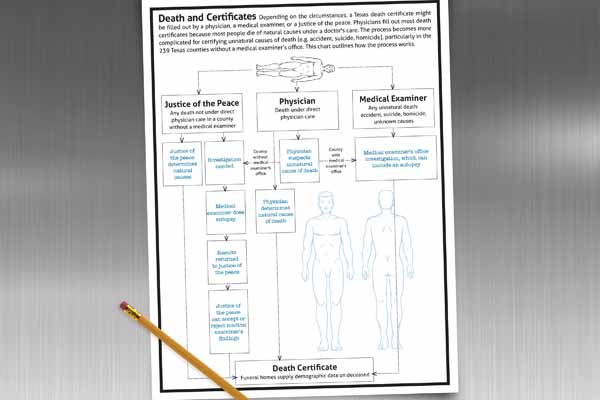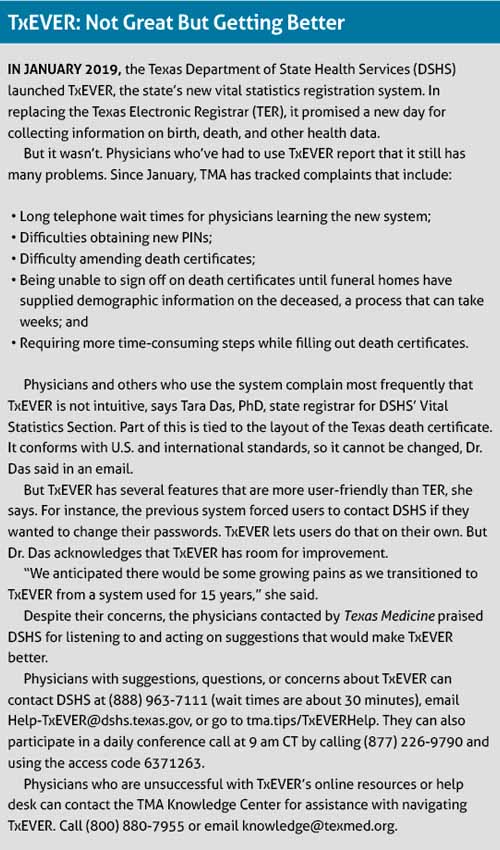
On Feb. 13, 2016, U.S. Supreme Court Justice Antonin Scalia was found dead at a luxury resort in rural West Texas near Marfa. The events that followed prompted a lot of questions in the press about how Texas handles death.
Responsibility for certifying Justice Scalia’s death fell that day to Presidio County Judge Cinderela Guevara. In Texas, only 15 of the state’s 254 counties have populations large enough to support a medical examiner’s office. In small counties like Presidio, a justice of the peace typically certifies the cause of death for someone who dies outside a physician’s care. But a justice of the peace wasn’t available the day Justice Scalia died, so under Texas law Judge Guevara got the call.
Judge Guevara later told reporters that she spoke to investigators from the sheriff’s office as well as Justice Scalia’s physician. With that information, she ruled that Justice Scalia died of natural causes. She made this ruling by phone, without ever seeing the body. This contributed to conspiracy theories that later erupted on the internet as to the true cause of death.
Yet Justice Scalia’s death investigation was handled according to Texas law and mirrored thousands of similar investigations in rural areas across the country each day, experts say. It points up that Texas, like most other states, has a mixed system for investigating death, where deaths outside of a physician’s care in rural counties are investigated by justices of the peace, and a professional medical examiner’s office fills that role in larger counties. (See “Death and Certificates,” page 26.)
A lack of uniform death certification services feeds into a larger problem about the way death statistics are compiled, says Marc Krouse, MD, Tarrant County’s chief deputy medical examiner. For instance, the attending physician is required to fill out a death certificate when a patient dies in a hospital. But training for physicians on filling out death certificates is inconsistent, and many physicians often put down the wrong factors as the cause of death.
“We’ll get a differential diagnosis [for the cause of death] involving totally unrelated diseases,” Dr. Krouse said.
This misleading information can be compounded by a lack of information on other fronts. While the number of medical examiner autopsies for suicide, homicide, accidents, and unknown causes has followed overall population growth, the number of autopsies for those who died of natural causes in hospitals has declined dramatically, says J. Keith Pinckard, MD, Travis County’s chief medical examiner.
As a result, in many cases nobody knows for sure what’s actually killing people because Texas no longer has a scientific way to check physicians when they list a cause of death, says Frank Papa, DO, associate dean for curricular design and faculty development at Texas College of Osteopathic Medicine in Fort Worth. He says studies show physicians can make a best judgment about what killed a patient and expect to be accurate 92% to 93% of the time, but that margin of error may actually be larger.
“The only way to know how a patient died is through autopsy,” he said.
Since death data is one of the foundations of vital statistics, these and other problems can have a major impact on public health, says Umair Shah, MD, executive director of Harris County Public Health and a member of the Texas Medical Association’s Committee on Infectious Diseases.
“Our systems of assessment and intervention – and ultimately measures of potential success – are based on [death statistics],” he said. “So we have to assure the absolute integrity of those.”
A public health problem
The death of Justice Scalia opened up Texas for criticism, but Texas is hardly the only state with room for improvement on certifying death. In October 2018, Robert Anderson, chief of the mortality statistics branch at the National Center for Health Statistics, told OZY magazine that he estimated inaccurate causes of death on death certificates as high as 20% to 30%.
“We don’t really have a good sense for how accurate death certificates are,” he said.
Jonathan Arden, MD, president of the National Association of Medical Examiners told Texas Medicine, “It’s an unfortunate but well-recognized concept that death certificate data are not as accurate as we’d like them to be.” Furthermore, he said, “If those are not accurate then we don’t have an accurate picture of how people are dying and are not allocating resources in the right way.”
Even before the controversy over Justice Scalia, Texas had other publicized problems with certifying death. For example, the Texas Maternal Mortality and Morbidity Task Force, which includes TMA member physicians, found discrepancies in 2010-12 maternal mortality statistics after comparing the death certificates case-by-case against medical records and other data. Errors on death certificates may have been at least partly to blame, according to a May 2018 study in Obstetrics and Gynecology prepared by task force members.
“Inconsistencies among cause-of-death codes, narratives, and pregnancy status on the death record have been observed for a number of maternal deaths in Texas,” the study said.
Aside from the maternal mortality study, there’s little information directly assessing the quality of Texas’ death statistics, physicians say. But studies in other states show the breadth of the problem:
• A 2010 New York City Health Department study found a 91% over-reporting of coronary heart disease on death certificates.
• A 2010 Louisiana State University study compared hospital discharge diagnoses with diagnoses on death certificates. It found that only 40.5% matched.
• A 2017 Missouri study found 48.5% of death certificates reported an incorrect cause of death.
• A 2017 University of Virginia study of death certificates from 1999 to 2015 found that U.S. opioid-related death rates could be 21% to 35% higher than previously estimated, depending on the year. Opioid-related deaths were consistently undercounted because specific drugs causing death are frequently not identified on death certificates, according to the study.
Despite problems with death statistics, even critics like Dr. Arden say they’re still helpful for a variety of public health issues.
In Texas, in addition to maternal mortality, health departments use death certificate data at the local level to identify influenza-related deaths during flu season, and to track the number of tobacco-related deaths, for example, says Philip Huang, MD, director of Dallas County Health and Human Services and a member of TMA’s Council on Science and Public Health.
“We recognize there are limitations to [the data], and so we try to interpret it within those limitations,” Dr. Huang said.
Death and Texas
Texas justices of the peace are similar to elected coroners employed in rural areas across the country. In Texas, justices of the peace are not required to have any medical training, but they do receive 80 hours of training in death investigation in their first year of service and another 20 hours in all subsequent years, according to Thea Whelan, executive director of the Texas Justice Court Training Center at Texas State University, which trains most Texas justices of the peace.
These officials take death investigations seriously, and if they have doubts about a death they are trained to refer it to medical examiners, says Judge David Cobos, justice of the peace in Midland County and president of the Justices of the Peace and Constables Association of Texas. Rural counties typically arrange to contract out autopsies with medical examiners elsewhere in the state, Judge Cobos said. For instance, Midland County contracts with Tarrant County’s medical examiner.
However, justices of the peace face financial pressure that medical examiners typically do not, says Dwayne Wolf, MD, deputy chief medical examiner for the Harris County medical examiner’s office. An autopsy costs about $2,500 and transportation costs can easily double that amount. Since many county governments are budget-conscious, justices of the peace must weigh the expense of each autopsy.
“Which means there’s a financial disincentive to get an autopsy done,” Dr. Wolf said. “It’s not that way in a medical examiner county.”

Justices of the peace also face more political pressure than medical examiners’ offices, Dr. Krouse says. He said families of the deceased often lobby either for or against having an autopsy, and justices of the peace frequently follow their wishes.
“The JP, being elected, will feel pressure, because the family will go to the [county] commissioners and complain,” he said.
Many justices of the peace have experience investigating deaths. For instance, Judge Cobos has investigated murders professionally as a county sheriff’s deputy.
Dr. Krouse says justices of the peace have impressed him with their ability to investigate deaths. However, those skills are not required for the job.
Dr. Wolf added: “You can imagine trained medical professionals having errors. People with no medical training are more likely to have even worse errors.”
Physician error
Errors by trained medical professionals also are a concern when it comes to death statistics, Dr. Krouse says. Texas’ system of registering deaths is similar to most other states. A medical examiner does an autopsy and fills out the death certificate for anyone who dies by violence or suspected foul play. In rural areas, a justice of the peace investigates deaths that occur away from medical care. The justice of the peace either fills out the death certificate in cases found to be natural death or refers cases to a medical examiner.
However, most patients die under a doctor’s care, so attending physicians fill out most death certificates. Dr. Krouse says while most do a good job they also get little practice because a typical physician fills out very few each year. Also, medical schools provide little or no training to help future physicians understand what information is needed and how to negotiate technical obstacles. As a result, errors creep into physicians’ record-keeping.
“I used to give lectures at a [local hospital] about how to fill out death certificates,” Dr. Krouse said. “The residents would listen but the staff doctors would get mad at me because I was telling them that what they’d been doing all along was not right.”
Perhaps the most common error physicians make on death certificates is confusing the mechanism of death with the cause of death, Dr. Pinckard says.
“For example, a death certificate might be filled out that says ‘cardiac arrest’ [as a cause of death],” he said. “Well, technically everyone who dies has cardiac arrest, so that’s not really a cause of death. That’s a mechanism. The question you’re trying to answer is why they had a cardiac arrest. You really want to get at the underlying disease.”
Physicians say problems like this have been exacerbated by technical difficulties in filling out the online death certificate required by the Texas Department of State Health Services (DSHS). In January 2019, DSHS replaced the often-criticized Texas Electronic Registrar (TER) with the new TxEVER system. Unfortunately, TxEVER also faces criticism from some physicians for being unintuitive and wasting physicians’ time. (See “TxEVER: Not Great But Getting Better,” right.)

Pending legislation also could affect how deaths are recorded in Texas. Currently, any county with a population of more than 1 million is required to set up a medical examiner’s office. At press time, TMA was monitoring House Bill 3716 by Rep. Tan Parker (R-Flower Mound), which would change that requirement to counties with a population of more than 2 million and potentially limit the number of medical examiner offices in Texas.
When it comes to filling out death certificates, both physicians and justices of the peace use inaccurate language to describe medical conditions, Dr. Wolf says. Also, physicians may be hamstrung by lack of knowledge. Despite being the attending physician, they may know little about a patient’s medical history, making it difficult to assess cause of death.
Even when physicians do everything right, they still may provide incorrect information for death statistics simply because they misdiagnosed the patient’s cause of death, says Dr. Papa.
In the 1970s, there was a good chance such misdiagnoses would be caught by routine autopsies, he says. However, the cost of the procedure and objections by family members have caused a steep decline in the number of hospital autopsies. A 2017 study in the Archives of Pathology & Laboratory Medicine reported that hospital autopsies dropped from as high as 40% in the 1960s to about 8% in the early 2000s.
The obvious answer is to go back to requiring more autopsies, Dr. Papa says. Returning to 1960s autopsy levels would be financially impractical. But doing autopsies on a slightly larger group of patients – like increasing the total by another 8% to 16% – would provide a benchmark for other death statistics, he says. To make them representative, the added 8% of autopsies would need to be done across the board, regardless of a patient’s ability to pay.
However, doing more autopsies or attempting other big changes – like replacing justices of the peace with medical examiners – are unlikely anytime soon because of cost, Dr. Arden says.
Even if the political will were there, the nationwide shortage of physicians makes finding enough forensic pathologists impossible, Dr. Pinckard adds. “There simply aren’t enough of us,” he said.
The growing use of electronic health records (EHRs), though unpopular with some physicians, may help improve the accuracy of death certificates, Dr. Shah says. EHRs that are interconnected nationally, like those at the U.S. Veterans Administration, allow physicians to get a more complete view of a patient’s medical history when filling out a death certificate.
“We live someplace, we work somewhere else, we travel for work or for pleasure to a third place,” Dr. Shah said. “We have all sorts of things that are happening, like car accidents. So many things can happen when we’re out of the immediate place where we go for our usual care.”
Death certificates also could be made more accurate with some simple fixes on the types of questions physicians have to answer, says Kimberley Molina, MD, deputy chief medical examiner for Bexar County. For instance, physicians often don’t know or can’t tell if their patient was once a smoker or how recently they were pregnant, and yet they are expected to report such information on a death certificate.
“If I have a woman who’s killed in a car accident, I’m very good at knowing if she’s pregnant when she dies,” Dr. Molina said. “But I may have no idea if she was pregnant months ago.”
However, family members often do know this information. Since funeral homes collect demographic information on the deceased when preparing a funeral, it makes sense for funeral homes to collect this data and relay it to the certifying physicians.
Dr. Molina echoed other medical examiners in calling for greater education among physicians and medical students about why death statistics are important and why filling out death certificates accurately is so vital.
“If we can just educate all the players,” she said, “that would go a long way.”
Tex Med. 2019;115(6):22-29
June 2019
Texas Medicine Contents Texas Medicine Main Page